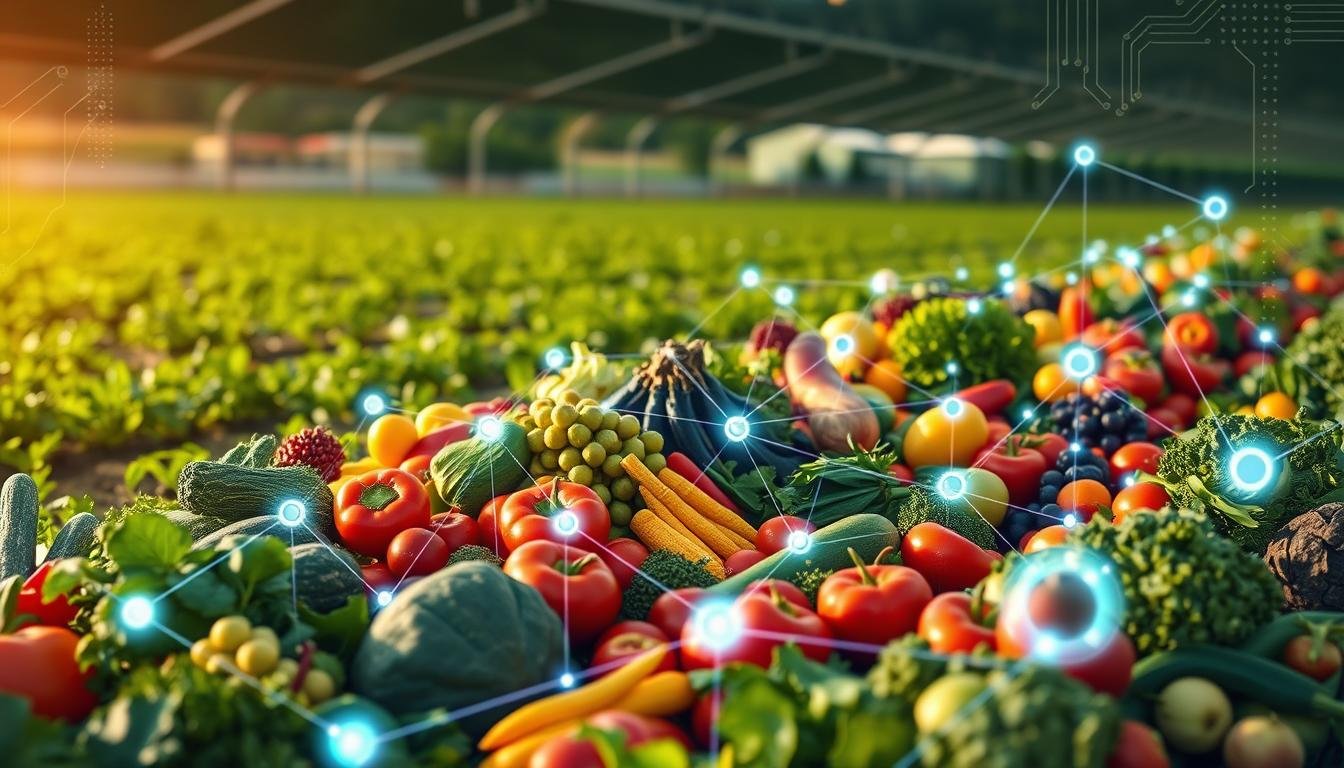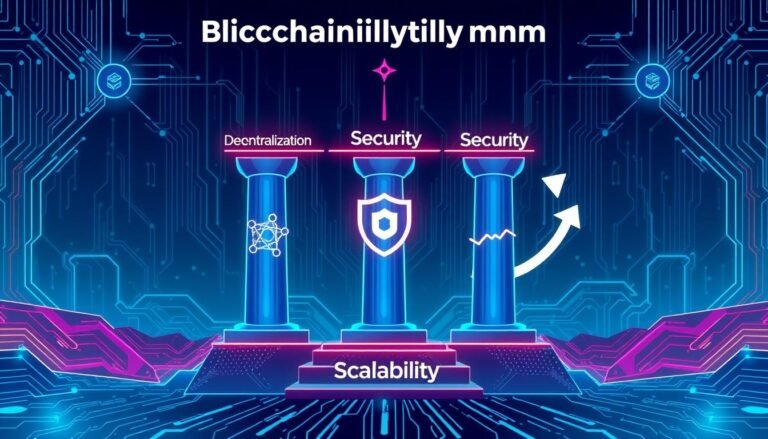Blockchain in Food Traceability
Blockchain technology is changing the food industry. It makes the supply chain more traceable and transparent. This is thanks to decentralized ledgers and verifiable credentials.
These tools help track food from farm to table accurately. This is key to solving old problems like foodborne illnesses and fraud. It also helps with the lack of data between different parts of the supply chain.
Key Takeaways
- Blockchain technology provides transparency and trust in food supply chains by ensuring immutable data records.
- Blockchain-based systems enable rapid traceability and containment of food contamination issues, reducing risks and food waste.
- Verifiable credentials and decentralized identifiers are crucial for establishing a trusted ecosystem in the food industry.
- Blockchain enhances transparency, allowing consumers to make informed decisions about the sustainability and ethical practices of food producers.
- Leading companies like Walmart, Ford, and Maersk are pioneering the use of blockchain for food traceability, showcasing its transformative potential.
Introduction to Blockchain Technology in the Food Industry
The food industry is seeing big changes thanks to Blockchain Technology in Food Industry. This new tech is changing how we track food from farm to table. It’s making food records permanent and improving Farm-to-Fork Traceability.
What is Blockchain and How Does it Work?
Blockchain is a digital ledger that keeps track of transactions on a network. It’s secure, open, and hard to change. In food, it helps track products through the supply chain.
The Importance of Food Traceability in the Supply Chain
Tracking food is key for safety, cutting waste, and gaining trust. Foodborne illness affects about 600 million people worldwide annually, with 420,000 deaths attributed to contaminated food each year. Blockchain makes tracking food easy and safe.
“By using Verifiable Credentials in blockchain systems, food data becomes tamper-resistant and highly accurate, reducing the risk of fraud and ensuring authenticity throughout the supply chain.”
Blockchain is making the food supply chain safer and more open. It’s solving old problems and making people trust the food they eat again.
Challenges of Traditional Food Traceability Methods
The food industry faces big problems with old ways of tracking food. These methods, based on manual tracking and incomplete records, are weak against Foodborne Illness Outbreaks and Supply Chain Fraud. They let contaminated products and fraud go unnoticed, causing harm and financial loss.
Foodborne Illness Outbreaks and Contamination Issues
Foodborne illness outbreaks can hurt a lot of people and the food industry. When tainted products get into the chain, finding and stopping them fast is key. But old systems and manual tracking slow down this process, leading to long outbreaks and big losses.
Supply Chain Fraud and Record Manipulation
Old food supply chains are also easy targets for supply chain fraud and record tampering. Scammers can change or fake paper records, hiding where food really comes from. This damages trust in the chain, puts companies at risk, and hurts their finances.
“The current food supply chain systems are often outdated, manual, and vulnerable to fraud and errors. Incomplete or inaccurate recordkeeping, slow response times during recalls, and lack of data transparency between stakeholders can lead to devastating foodborne illness outbreaks and significant financial losses.”
We really need a better, more open food traceability system. New tech, like blockchain, could solve these old problems. It could change how we keep food safe and honest.
Blockchain in Food Traceability
Blockchain technology, combined with verifiable credentials and decentralized identifiers (DIDs), is a strong tool for better food traceability. Each food item gets a unique DID. As it moves, verified credentials are added, making a permanent record of its path.
The Role of Verifiable Credentials and Decentralized Identifiers
Verifiable credentials are digital proofs of a food’s authenticity and origin. They’re stored on the blockchain, making them safe and easy to access for everyone in the supply chain. Decentralized identifiers (DIDs) are unique blockchain IDs that track each food item’s movement and origin.
How Blockchain Enhances Food Traceability and Transparency
Blockchain, verifiable credentials, and DIDs help quickly find contamination sources. They give everyone a reliable source of info on a product’s origin, quality, and safety. This leads to less food waste, better safety, and more ethical sourcing.
Several companies are using blockchain for food traceability. For example:
- Ripe.io lets consumers see detailed info about their food, like where it came from and its environmental impact.
- Trusty has clients worldwide, helping with traceability and ethical sourcing.
- TE-FOOD is used by over 6,000 businesses, tracking thousands of food transactions daily.
- Provenance has tracked over 1 million products, aiming to increase food supply chain transparency.
As blockchain tech improves, so will Blockchain Food Traceability and Immutable Food Data. This will benefit both consumers and producers.
Benefits of Blockchain for Food Traceability
Blockchain technology is changing the game for food traceability in the supply chain. It brings many benefits that solve old problems and increase transparency, efficiency, and trust.
Accurate and Tamper-Resistant Food Data
Blockchain-based systems keep food data accurate and safe from tampering. Verifiable Credentials are encrypted, so food information like origins and quality can’t be altered easily. This ensures data integrity, helping everyone make better choices and gain consumer trust.
Rapid Contamination Containment and Reduced Food Waste
Blockchain helps find and stop contamination fast. It quickly identifies the source, allowing companies to remove bad products quickly. This cuts down on food waste and saves money for everyone involved.
| Metric | Improvement |
|---|---|
| Time to trace contaminated batches | From 7 days to 2.2 seconds |
| Efficiency in tracing food contamination | Significant improvement |
Blockchain also makes it easier to produce and distribute food sustainably. This meets the growing need for eco-friendly practices in global supply chains.
“Blockchain technology ensures the security and immutability of information required for ESG reporting, addressing the need for companies to gather and disclose data on the social and environmental impact of their activities to meet regulatory requirements.”
Using blockchain for food traceability boosts consumer trust, cuts down on waste, and supports green practices. These efforts make the food supply chain stronger and more open.
Pioneers in Blockchain Food Traceability: Walmart’s Success Story
Walmart is a big name in retail and a leader in using blockchain technology for food traceability. In 2016, they teamed up with IBM to start a blockchain system. This system could track mangoes from US stores in seconds, down from 6 days before.
Walmart is serious about making food safer and more transparent. They’ve worked with other big names to create the IBM Food Trust. This platform uses blockchain to make food safer and more open across the globe.
| Walmart’s Blockchain Food Traceability Achievements | Impact |
|---|---|
| Reduced tracing time for mangoes from 7 days to 2.2 seconds | Enables rapid identification of contaminated or recalled products, minimizing health risks and reducing food waste |
| Expanded blockchain traceability system to pork supply in China | Improved trust in the supply chain by allowing the upload of certificates of authenticity to the blockchain |
| Collaborated with IBM to establish the IBM Food Trust platform | Brought together key players in the food industry to enhance Blockchain Supply Chain Transparency and Food Safety Initiatives |
Walmart’s work in Walmart Blockchain Food Traceability has raised the bar for the industry. It shows how blockchain can change the game for food safety and openness in the supply chain.
“Blockchain technology could revolutionize food supply chain management by enabling quick traceability of contaminated foods, with the potential to reduce tracing time from days or weeks to a few seconds, significantly improving transparency and ensuring food safety.”
Conclusion: The Future of Blockchain in Food Traceability
The food industry faces big challenges like foodborne illness and supply chain fraud. Blockchain technology is a game-changer. It creates a secure, decentralized record of food products’ paths.
This could change how the industry works. It could make food safer, cut down on waste, and gain consumer trust.
The future of blockchain in food traceability looks bright. More companies are looking into how it can help. It could lead to more sustainable agriculture and a transparent global food supply chain.
Blockchain can keep data accurate and safe from tampering. It helps quickly find and stop contamination. It also helps reduce food waste.
As more companies use blockchain, we’ll see big changes. Food traceability systems will become more common. This will make the global food supply chain safer, more efficient, and open.
The impact of blockchain on food safety will be huge. It has the power to make a real difference. It could help build trust in the food industry.
Source Links
- Blockchain in the food supply chain – What does the future look like?
- Blockchain For Food Traceability | Food Safety and Transparency
- Blockchain Food Traceability: Enhancing Transparency and Safety
- Blockchain Technology in the Food Industry
- Blockchain-Based Frameworks for Food Traceability: A Systematic Review
- Redefining food safety traceability system through blockchain: findings, challenges and open issues – Multimedia Tools and Applications
- Food Traceability with Blockchain
- Blockchain’s Impact on Food Safety & Traceability
- Blockchain for Food: 10 Examples to Know | Built In
- The Power of Blockchain in Revolutionising the Food Industry | Deloitte Netherlands
- Blockchain in Food Supply Chain | Food Supply chain | Blockchain
- How Walmart Enhances Food Safety with IBM Blockchain Technology
- How Walmart brought unprecedented transparency to the food supply chain with Hyperledger Fabric
- Blockchain Use Cases in Food Traceability: Opportunities and Challenges
- Microsoft Word – EQAIQYFDYD.docx





